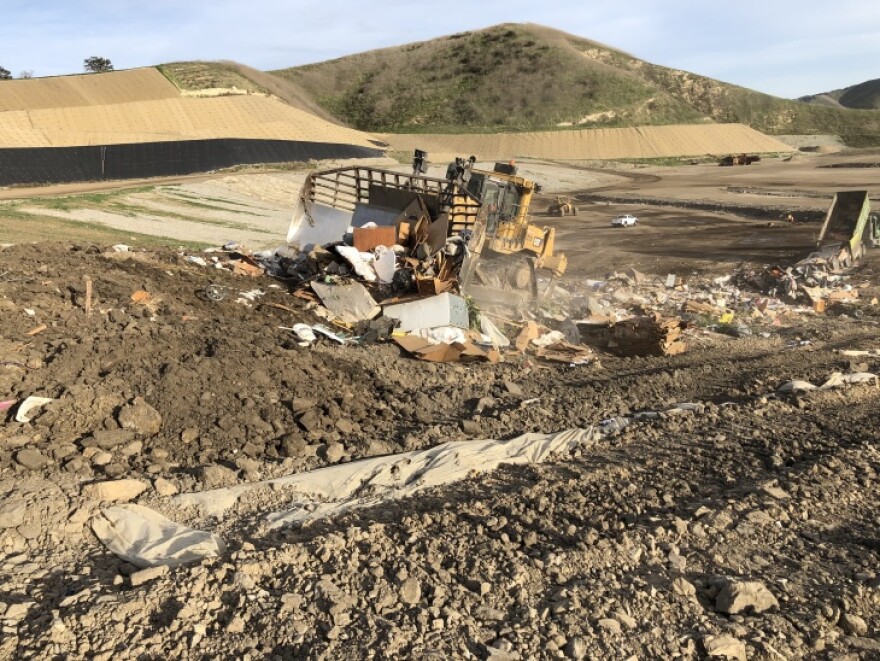This story is free to read because readers choose to support LAist. If you find value in independent local reporting, make a donation to power our newsroom today.
'Zombie' Landfills Emit Tons Of Methane Decades After Shutting Down. Here's Why That's A Big Problem

Landfills are one of California’s largest sources of the greenhouse gas methane, which is dozens of times more powerful than carbon dioxide at heating up the planet. But even when landfills shut down, they keep emitting tons of the stuff, according to state data.
Why landfills emit methane
Food makes up about 18% of the waste in our landfills and when that food decomposes, it creates methane. To lower methane emissions, the state mandated large-scale composting to keep more food waste from getting into landfills. (More on that here).
Some of the state’s biggest methane emitters are landfills here in the Southland, including those that have been closed for decades. One landfill in West Covina that closed more than 25 years ago, for example, still emits some of the most methane in the whole state, according to Environmental Protection Agency data analyzed by climate organization Industrious Labs, which focuses on lowering emissions in heavy industry such as waste management, steel and cement.
“This out-of-sight, out-of-mind mentality with our trash is an illusion,” said Katherine Blauvelt, a policy expert with Industrious Labs. “It's impacting us every day and actually for decades.”
About half of the landfills the California Air Resources Board (CARB) regulates for emissions are actually officially closed, she said.
Monitoring landfill emissions
Blauvelt says the good news is that plugging leaky landfills is usually relatively cheap, and slashing methane gas has an immediate impact on slashing global heating because it doesn’t get baked into the atmosphere for decades like carbon dioxide does.
Landfills are required to monitor and report their emissions to CARB. Only larger landfills are required to continue reporting emissions data to the state once they close. That monitoring consists of a person walking around the landfill in a grid pattern four times a year with a monitoring instrument to identify potential leaks, Blauvelt said.
Many landfills have methane capture systems — a system of pipes that captures the gas before it escapes into the atmosphere. Blauvelt said those pipes are prone to leaking, which is why monitoring is so important.
“There could be a number of reasons why the leak is happening,” Blauvelt continued. “But if you never find it — that's really a principal issue that we're all facing in California.”
But there are some major gaps in monitoring these leaks, Blauvelt said.
- When a landfill closes, current state regulations allow operators to remove their gas capture system after just 15 years. But CARB’s own data shows methane emissions from closed landfills can continue for 30 years or more. The state is considering updating that regulation to require operators to prove they don’t have significant methane emissions before removing those systems.
- Monitoring only happens four times a year, and it’s done by the operator, not a third party. To address this, the state has set aside funding to set up a network of satellites to monitor large methane emissions in real-time. That’s expected to be online early next year, and Blauvelt said it could be a “game-changer” when it comes to quickly plugging methane leaks.
Most methane leaks at landfills are a result of erosion or cracks in the covers over landfills or a leak or clogging of the methane capture pipe systems, Blauvelt said.
And those are pretty easy things to fix.
“The good news is you don't need to split an atom to fix the problem,” she said. “It won’t break the bank. And the great news is if you mitigate even a little bit of methane, it has an immediate positive impact on global warming.”
Data to arm communities
The majority of landfills are within 1 mile of communities that are below national income levels and whose residents are predominantly people of color.
That’s why Blauvelt said she also hopes the interactive maps that Industrious Labs put together will help communities advocate for themselves. The dashboard pinpoints open and closed landfills across California and is easy to navigate.
Blauvelt said communities can “then take that information to their local elected official or state elected official and ask, ‘What can we do to address this?’”
She said the issue of “zombie landfills” emitting methane long after they shut down also puts a fine point on why it’s so important to compost your leftovers instead of tossing them in the trash.








